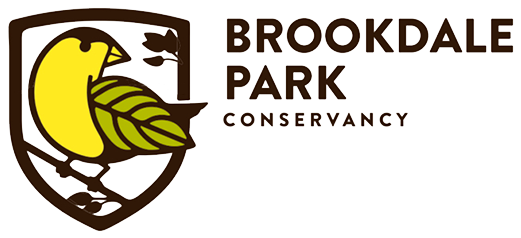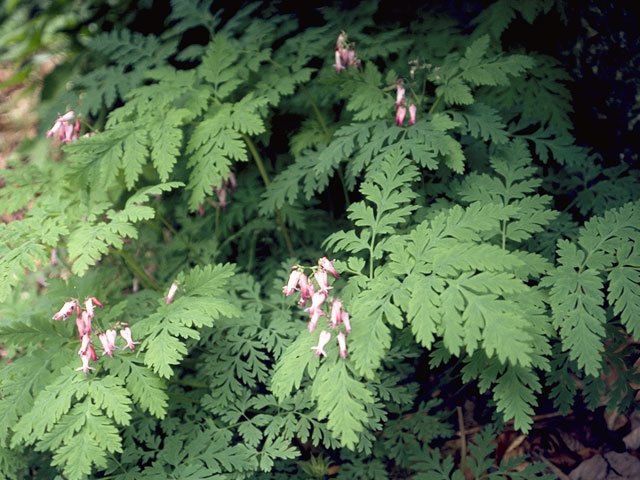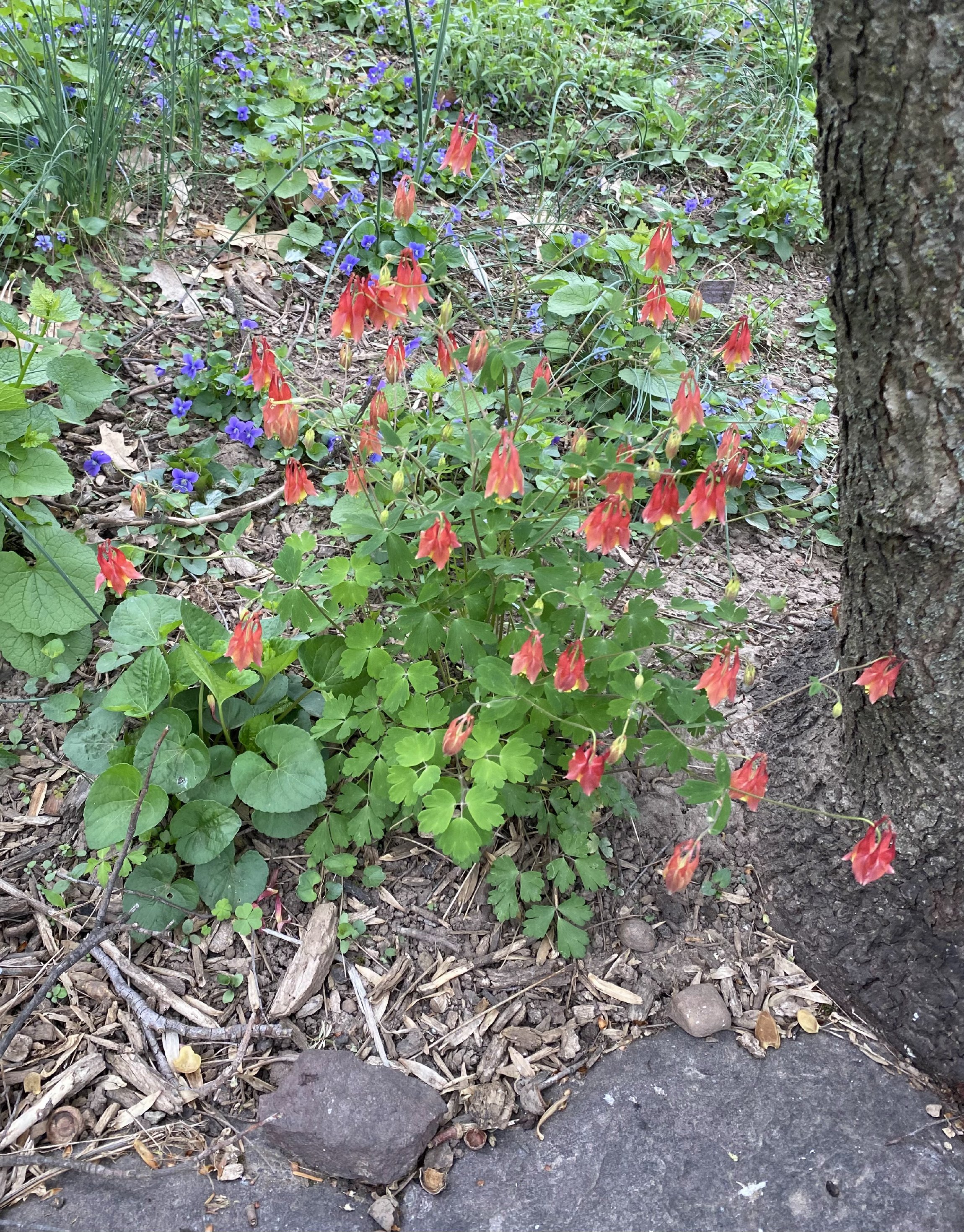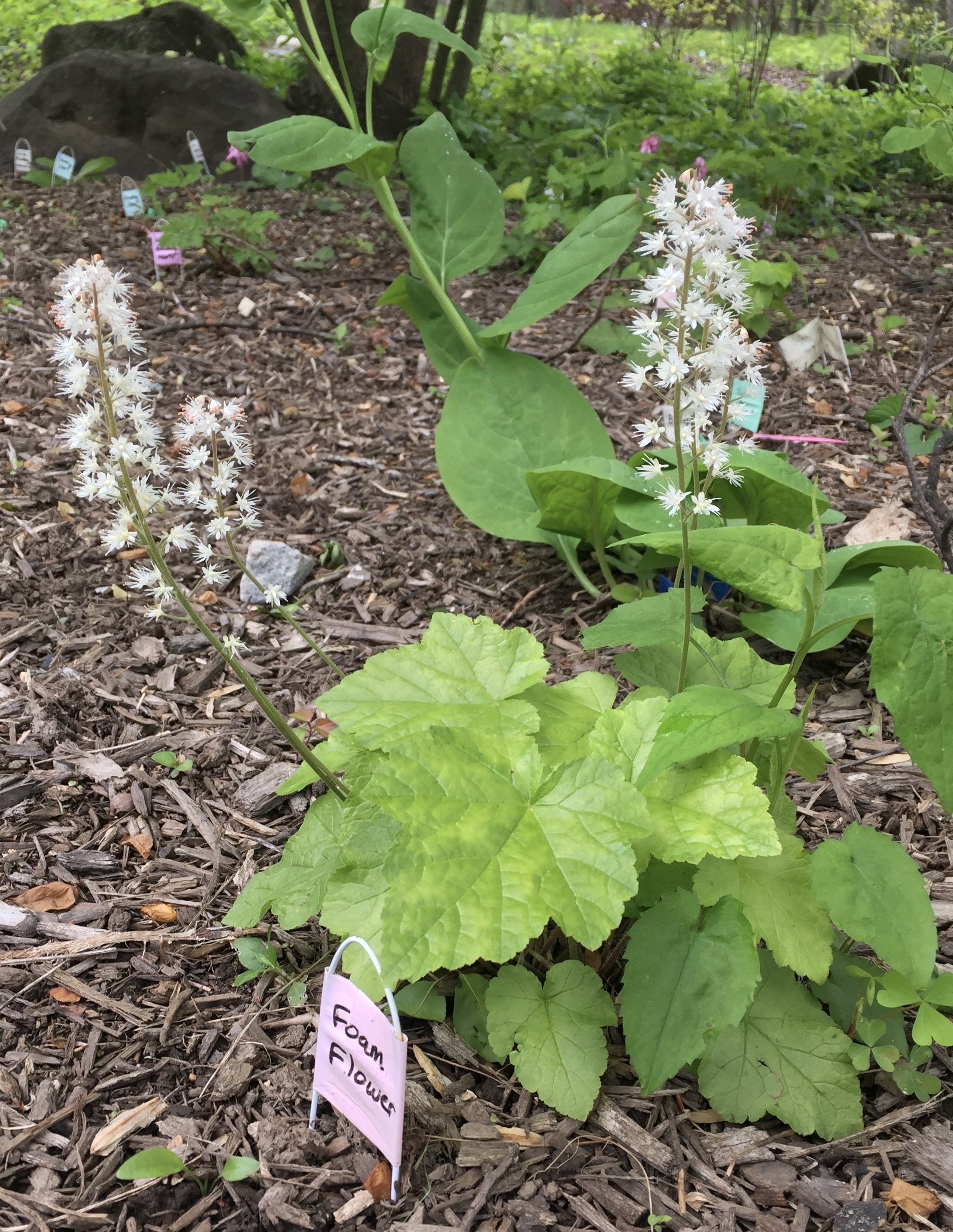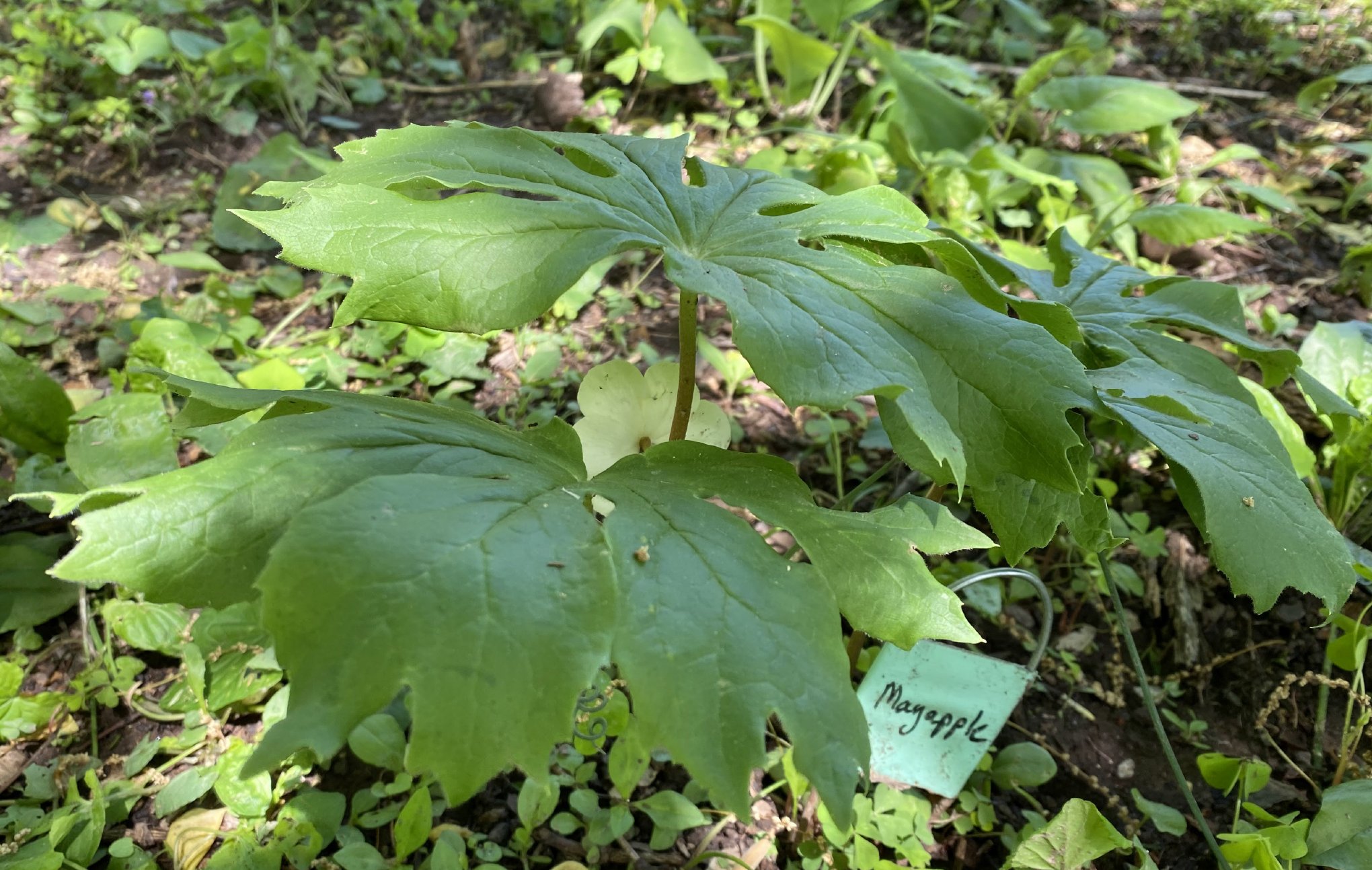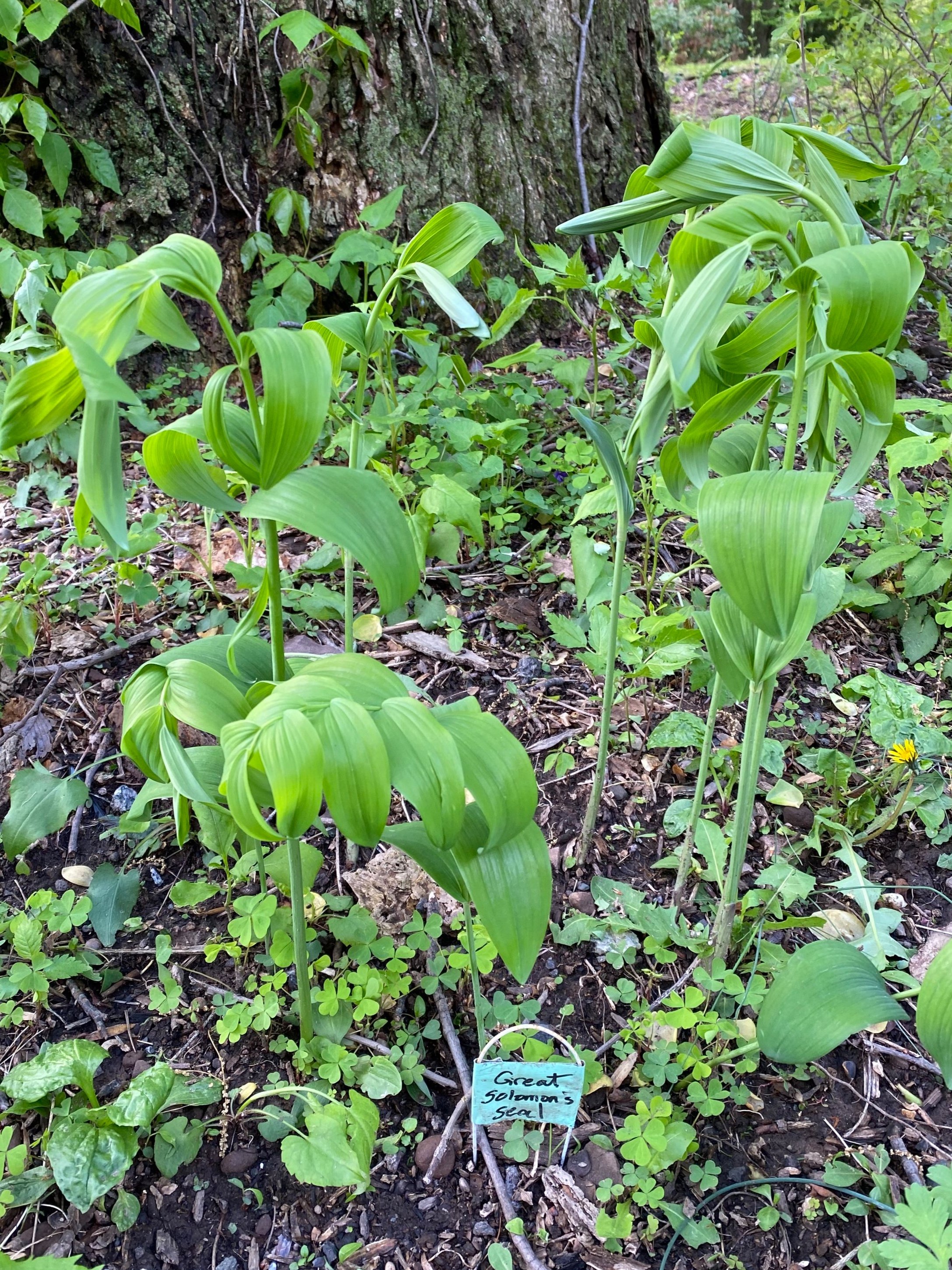woodland Garden
EASTERN BLUESTAR
Amsonia tabernaemontana
The blue star-shaped flowers bloom in mid-spring. Leaves turn a pretty yellow in fall. Easy plant to grow. Looks great as an accent plant and also en masse. Prune after flowering to avoid flopping over.
Attracts: Bees and other pollinators
Growth: Perennial, 2-3’h, Full sun/partial shade, tolerate of most soil types, likes moist well-draining soils, some deer resistance
Blooms: Mid spring
Location: Woodland Garden
CANADA ANEMONE
Anemone canadensis
When in ideal conditions, this perennial in the buttercup family will spread quickly, making it a good ground cover. The white flower with yellow center sits atop a delicate whirled leaf and blooms in mid-late spring. It’s found in woodlands, along rivers and in moist meadows and thickets.
Attracts: Bees and other pollinators
Growth: Perennial, .5-1’, partial shade to shade, tolerates most soil types, likes moist soil, good deer resistance.
Blooms: Mid late spring
Location: Woodland Garden
BLUE WOOD ASTER
Symphyotrichum cordifolium
This late-blooming (late summer-fall) perennial is a much needed nectar source for pollinators in fall. The flowers are a mix of blues and purples. Cutting back the flowers in mid-July will create bushier plants and will prevent it from falling over.
Attracts: Butterflies including the Pearl Crescent seen at the garden
Growth: Perennial, 2-4’, full sun to part shade, tolerates all soil types but prefers moist, rich soils,
Location: Every part of the garden
Courtesy W.D. and Dolphia Bransford, Lady Bird Johnson Wildflower Center.
BLEEDING HEARTS, WILD
Dicentra eximia
With its fringed foliage and delicate pink heart shaped flowers the wild bleeding heart is a lovely addition to a shady garden. Its foliage will provide color into autumn
Attracts: Bees, butterflies, hummingbirds
Growth: perennial, 1-1.5’ h, part shade, rich dry soil
Bloom: April - June,
Location: Woodland Garden
BLOODROOT
Sanguinaria canadensis
Bloodroot sap was used medicinally by Native Americans and is currently researched as an anti-cancer agent. Dyes can be made from its sap. Ants spread this plant. They eat only the fleshy covering of the seeds and carry the actual seeds out of the nest with their waste. The plants then grow on the ant’s “trash heap”.
Attracts: ants, bees
Growth: perennial, .5-1’ h, shade, moist, well drained soil
Bloom: April - May
Location: Woodland Garden
BLUEBELLS, VIRGINIA
Mertensia virginica
This ephemeral plant emerges early in the spring and goes dormant early in the summer. The flowers are a delicate blue and make a great statement here in the park or in a home spring garden. It is easily naturalized in your garden if you take care to not plant over it while it is dormant.
Attracts: butterflies/moths, bees, hummingbirds
Growth: perennial, .5-1’ h, shade, moist soil
Bloom: April - May
Location: Woodland Garden
BLUE MIST FLOWER
Conoclinium coelestinum
The compact clusters of blueish white flowers bloom from mid summer until frost. It is an important food source for native bees. In the home garden cutting it back in the middle of the summer will make it bushier. It spreads by rhizomes and will need dividing to keep it in check.
Attracts: Native Bees, butterflies Hosts: Lined Ruby Tiger Moth
Growth: perennial, 1-2’ h, full sun/part shade, dry/moist soil
Bloom: August - October
Location: Pollinator Patch, Milkweed Slope, Woodland Garden
COHOSH, BLACK
Actaea racemosa
The tall fragrant flowers of cohosh dance above the lacy foliage in the early summer, Planted in masses at the back of a shady border these native plants pack a visual punch. Cohosh has a long history of medicinal use, Native Americans treated many conditions with it, and it is still used in medicines today.
Hosts: Spring Azure Butterfly
Growth: perennial, 2-5’ h, shade, moist organically rich soil
Bloom: May - July
Location: Woodland Garden
COLUMBINE, WILD EASTERN, GOLDEN
Aquilegia canadensis “Corbett”
Columbines do well in the home garden and will self seed to form a patch. If watered occasionally the attractive leaves will last into the summer. The scientific name comes from “aquilae” the latin word for eagle, as the 5 spurs of the flower resemble an out-stretched eagle’s talon.
Attracts: Hummingbirds Hosts: Columbine Duskywing Butterfly
Growth: perennial, 1-1.5’ h, sun/part shade, well drained soil
Bloom: March - June
Location: Woodland Garden
Columbine, Wild Eastern, Red
Aquilegia canadensis
This versatile beauty does well in beds, borders, woodland’s edges and container pots and is a wildlife magnet. When well placed, Columbine will self seed and form colonies. Plant and watch hummingbirds drink nectar from its bell-shaped flowers.
Attracts: Hummingbirds, bees, butterflies, Hawk moths, birds. Host to Columbine Duskywing Butterfly
Growth: 1-2’h, partial shade, moist soil, deer resistant
Blooms: April, May
Location: Woodland Garden, Milkweed Slope, Shady Slope
Foamflower
Tiarella cordifolia
Foamflower gets its common name from the long stamens covered in tiny white flowers which gives it a foamy appearance. It spreads quickly by runners to form clumps of 1-2’ heart-shaped foliage. Good ground cover for woodland garden or shady spot.
Attracts: Bees, butterflies, other pollinators
Growth: .5-1’ h, Part/full shade, organically rich soil
Blooms: April-June
Location: Woodland Garden, Shady Slope
Goat’s Beard
Aruncus dioicus
The blooms on this towering beauty are reminiscent of Astilbe. It can get as tall as 6 feet and thrives in moist, organically rich soil. A good candidate for a rain garden,
Attracts: Bees, Butterflies,
Host to Dusky Azure Butterfly
Growth: 4-6’h, Sun/Part Sun, Shade, Moist soil, tolerates flooding
Blooms: April-June
Location: Woodland Garden
JACK-IN-THE-PULPIT
Arisaema triphyllum
The unique flower form inspires this plant’s common name. There is an erect flower spike hidden inside a sheath that looks like a pulpit. The plant has both male and female flowers. The female flowers produce a cluster of bright red berries in late summer. If you have the right conditions this unique flower is a great addition to your garden.
Attracts: flies to pollinate and birds for seeds
Growth: perennial, 1’h, shade, rich loamy soil
Bloom: April-May
Location: Woodland Garden
MAYAPPLE
Podophyllum, peltatum
Two large leaves on this plant hide a small white flower that produces the “apple”, Look carefully in this picture and you can see a flower a little right of center. The fruit is eaten by small mammals and Eastern Box Turtles, all other parts of the plant are toxic if eaten.
Attracts: Bees and other pollinators
Growth: perennial, 1-1.5’, shade part/shade, dry/moist soil
Bloom: April-June
Location: Woodland Garden
MERRY BELLS
Uvularia grandiflora
The large yellow lily-like flowers and big leaves are heavy and cause this plant to have a droopy appearance providing an interesting contrast to ferns and other woodland plants. While relatively carefree, it can be attractive to deer.
Host plant: Andrena uvaleriae - a ground nesting solitary bee
Growth: perennial, 1-1.5’ deep shade, well drained moist soil
Bloom: April-May
Location: Woodland Garden
MILKWEED, Common
Asclepius syriaca
Milkweed’s unique flower supports a complicated pollination strategy. First, a visitor’s leg accidentally falls into a crevice in the flower, when it’s extracted a pollen sack attaches to the leg. Milkweeds bank on the insect then going to another milkweed flower, accidentally getting its leg caught again and leaving the pollen sack behind. Orchids have a similar pollination strategy - more details can be found here
Attracts: Bees, Butterflies, Hummingbirds Host plant: Monarch Butterfly
Growth: perennial, -4+’h, sun/part shade, all soil types
Bloom: May-June
Location: Entire Garden
Shooting Star
Dodecatheon meadia
The flowers are “buzz pollinated”. Bumblebees hang below the flower, vibrating their wing muscles without moving the wings. This shakes pollen onto the bee’s abdomen. When the bee has collected enough pollen she grooms it onto her legs to carry to the nest and feed her larvae. Pollen is a rich source of protein for bees. Only bumblebees and some native bees can perform this feat.
Attracts: bumblebees and native bees
Growth: perennial, 1-2’h, part shade, moist (not wet) soil
Bloom: March-May
Location: Woodland Garden
Snakeroot, White
Ageratina altissima
As one of the latest blooming flowers its nectar is important for bees, butterflies and moths preparing to overwinter or migrate. The milk from cows that eat this plant can cause vomiting, tremors, liver failure and death. Abraham Lincoln’s mother is thought to have died from this “milk sickness”.
Attracts: bees and butterflies,
Growth: perennial, 1-3’h, part shade, moist rich soil
Bloom: August-October
Location: All areas
Courtesy Alan Cressler, Lady Bird Johnson Wildflower Center.
Solomon’s Seal
Polygonatum biflorum
Solomon’s Seal flowers hang down under the arching stems and lead to blue black berries in the fall. These are graceful plants for a shady border or naturalized area in your yard.
Attracts: butterflies, birds
Growth: perennial, 1-2’h, part shade, most soils
Bloom: April-May
Location: Woodland Garden
Solomon’s Seal, Great
Polygonatum biflorum var commutatum
Also known as Giant Solomon’s Seal this plant should be given plenty of room! While some people eat the spring shoots treating them like asparagus, the berries are toxic to humans and should be left for the birds.
Attracts: butterflies, birds
Growth: perennial, 2-3’h, sun/part shade, most soils
Bloom: April-May
Location: Woodland Garden
Trillium, White
Trillium grandiflorum
This graceful flower is a cheerful find on a spring woodland walk. It first sends up a set of 3 leaves and then the flower emerges - again in threes - three lily-like petals with three green sepals. Berries follow and ants help disperse the seeds.
Attracts: ants, bees, flies, beetles, butterflies
Growth: perennial, .5-1’h, part/full shade, rich, moist, well drained soil
Bloom: March-May
Location: Woodland Garden
Vervain, White
Verbena urticifolia
Historians document the use of white vervain as a medicinal herb during the American Revolution. A wildlife magnet, the long blooming season provides a cool white notes to a shady garden well into fall while its spiky growth habit adds an interesting structure and its dormant dusty grey leaves provide a contrast to fall foliage.
Attracts: bees, wasps, butterflies, and flies
Growth: perennial, 3-5’h, shade, well drained soil
Bloom: June-October
Location: woodland garden
Photo credit R.W. Smith, Wildflower Center Digital Library
Violets
Viola sororia
Violets are our state flower and important our ecosystem. Fritillary butterfly larvae eat only violets. While some people prefer a very tidy lawn or flower border, letting violets run through your yard provides color and supports fritillaries. Violets come in a variety of colors, blue, pink, white and bi colored.
Attracts: bees, butterflies, birds Host plant: Grand Spangled Fritillary, Variegated Fritillary Butterflies
Growth: perennial, .5’h, sun/part shade, well-drained soil
Bloom: April-June
Location: Milkweed and Shady Slopes, Woodland Garden
shrubs & vines
Coral Honeysuckle
Lonicera sempervirens
This native honeysuckle vine is a winner, plant it in your garden and train it on a fence or trellis to be treated to its red/pink/orange flowers. Hummingbirds find the flowers irresistible and in the fall the seeds are sought after by finches and robins.
Attracts: bees, butterflies, hummingbirds, birds Host plant: Spring Azure butterfly and Snowberry Clearwing moth
Growth: vine, up to 12’ long, sun, most dry soils
Bloom: May-June
Location: Milkweed Slope, Woodland Garden, Shady Slope
Poison Ivy, Eastern
Toxicodendron radicans
Poison ivy can be on a tree, bush or or on the ground. “Leaves of three let it be” is wise advice! The middle leaflet is longer than the two side leaflets. Leaves can be glossy or dull, smooth-edged or toothed. The itch/burn takes between 12 hours and 5 days to develop. You can also be irritated from clothes and other items that touched the ivy. It is best to take care and avoid it. Rutgers has advice to address it in your yard.
Growth: vine, 20+’ l, grows in most soil/light conditions
Bloom: Spring
Location: entire garden
Sumac, Fragrant
Rhus aromatica
This bush has yellow flowers which are followed by red berries which are eaten by birds; it is a stand out in the fall when the aromatic leaves turn orange/red/reddish-purple. Planted in a group in a border or on a slope this is a unique and stunning landscaping choice, plus its a native plant with wildlife value.
Attracts: bees, butterflies Host plant: Red-banded Hairstreak Butterfly
Growth: shrub, 3’h, sun, most soil dry
Bloom: Spring
Location: Woodland Garden
